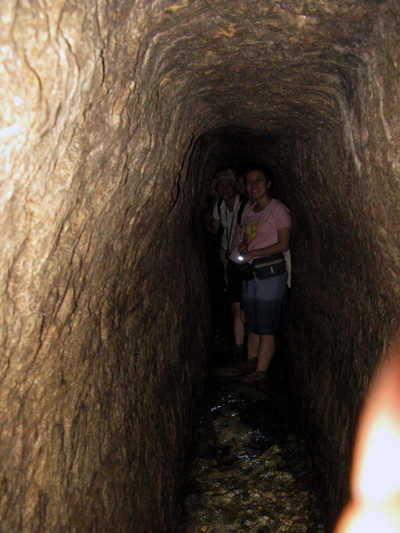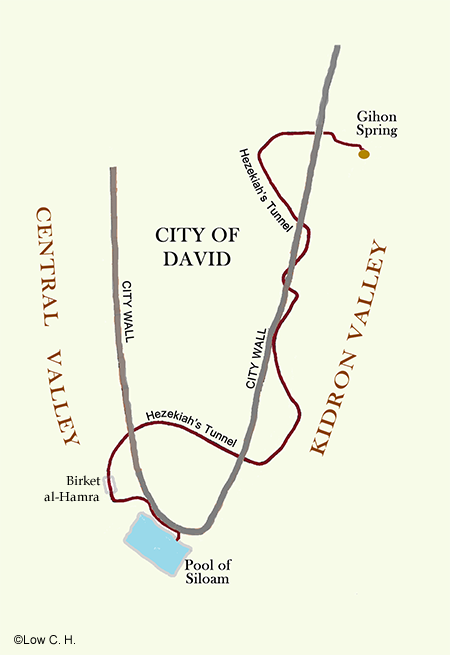
The tunnel beneath the city of Jerusalem ordered dug by King Hezekiah to bring water from Gihon Spring, which lie outside the city wall, to the Siloam Pool inside the city, in anticipation of the siege by Assyrian forces. The account of the decision to construct the tunnel is found in 2 Chro 32:2-4 & 30.
As the Assyrian army approached Hezekiah began to make defensive preparations (2 chr 32:1-5). One of the most important of these had to do with the supply of water to the city. Jerusalem's main source of water was a single perennial spring, known as the Gihon, which lay outside the city-wall. This was supplemented by a system in which rain water and water from spring in the surrounding were channelled into underground cisterns. A city like Jerusalem was, therefore, especially vulnerable if its water supply was compromised. Thus we read in 2 Chr 32:3-4 & 30:
He consulted with his officials and military staff about blocking off the water from the springs outside the city, and they helped him. A large force of men assembled, and they blocked all the springs and the stream that flowed through the land. "Why should the kings of Assyria come and find plenty of water?" they said. . . It was Hezekiah who blocked the upper outlet of the Gihon spring and channeled the water down to the west side of the City of David.
Of Hezekiah's accomplishments it was this act that the author of Kings seems to remember the best, for as he brings his account of the king to a close he says (2 Ki 20:20):
As for the other events of Hezekiah's reign, all his achievements and how he made the pool and the tunnel by which he brought water into the city, are they not written in the book of the annals of the kings of Judah?
Today the tunnel is a popular site for tourists to Jerusalem, and can be traversed in about half an hour.

Tourists wadding through the tunnel.
The Gihon Spring sat very near to the floor of the Kidron Valley, just below the ancient City of David, though today you would have to walk down a flight of steps to get to it because of the debris that had collected on the valley floor since. The spring does not issue a continuous flow but gushes periodically; hence the name"Gihon," i.e., "the gusher." The tunnel begins at the Spring and terminates at the southern end of the City of David at a pool that today is called Birket al-Hamra; in the OT the pool is not identified though it is often thought to be the Pool of Siloam. This uncertainty is made more puzzling because new excavations just a few meters further south have revealed another pool that archaeologist now identify as the NT Pool of Siloam, raising the question how the two pools are related to one another and to the Tunnel.

The pool at Birket al-Hamra, once
thought to be the Pool of Siloam.

Excavation of what archaeologists now believe was New Testament Pool of Siloam.
The straight line distance between the Spring and the pool of Birket al-Hamra is about 323 m. The tunnel, however, traces a course that is an elongated-S, so that the actual length of the tunnel turns out to be 538 m.

Though the Bible is silent on how the tunnel was accomplished, an inscription found on the wall inside the tunnel gives us an account of how it was done. Two teams were involved, digging from the two ends of the tunnel. The inscription captures the excitement of the moment the two teams met:
Behold the tunnel. This is the story of its cutting. While the miners swung their picks, one towards the other, and when there remained only 3 cubits to cut, the voices of one calling his fellow was heard—for there was a resonance in the rock coming from both north and south. So the day they broke through the mines struck, one against the other, pick against pick, and the water flowed from the spring towards the pool, 1200 cubits. The height of the rock above the head of the miners was 100 cubits.
It remains a mystery how the two teams could find their way towards one another since the tunnel was not a straight line. Sometimes the tunnel would end a foot or so in one direction before turning in another direction, suggesting that there were false starts as they worked their way through. Most of the way the tunnel is so narrow that only one person can pass through at a time. Here the miners worked by the dim light of oil lamps, every single rock chip chiselled having to be carried back out for disposal. And time was pressing, if the tunnel was to serve its intended purpose with the Assyrian army approaching. Moveover, they maintained a very gentle slope, just 2.18 m, or 0.4%;1 how were they able to achieve such precision for the channel that would not create a torrent? Robert Coote phrases the amazing engineering feat that it is:
"... the remarkable achievement was not that the crews met over the last meter and a half, but that they ever came that close to each other in the first place. The tunnel follows not a straight line but a ragged s-shaped curve. . . Whatever the purpose of this intentionally winding path—long a puzzle to investigators—it vastly complicated the survey required by the head engineer, and hence magnifies his accomplishment. When each crew was between 40 and 45 m from the eventual meeting-point, the engineer initiated a series of at least four highly accurate corresponding corrections in both tunnels that brought the crews within shouting distance. . . The successful joining of the tunnels demonstrated the engineer's proficiency with the primitive means at his disposal."
Robert B. Coote, "Siloam Inscription," The Anchor Bible Dictionary ed by D. N. Freedman (New York: Doubleday, 1992) V1:24.
Just as amazing was how the inscription came to be discovered. Simon Goldhill tells the story:
Jacob Eliahu was formally adopted by the Spaffords, leaders of the American Colony, at family prayers on July 9, 1883, when he was eighteen years old. He had been born a Sephardi Jew in Ramallah and was a rave success story of the London Missions to the Jews . . . He was a bright boy with a keen interest in archaeology. He had already lived with the Spaffords for a good time. A couple of years before, Jacob had become very excited by the thought of Hezekiah's Tunnel. Parts of the tunnel had been explored by Captain Warren, who was lionized in London for his bravery . . . it was always said, especially among the boys with whom Jacob played, that the tunnel was haunted by a genie, or by a dragon. Jacob knew this would be an adventure. . . he managed to persuade a friend, Sampson, to join him in exploring the tunnel for themselves.
They did not know how long it was or how deep the water. They prepared floads with candles and matches attached, which they tied around their necks. Jacob started from one end and Sampson from the other, intending to meet in the middle. Quckly, Jacob found himself in muddy water up to his chin. The light blew out, but the matches were already too damp to relight it. He kept going, damp stone and feeling the chisel marks of the ancient construction workers on the wall. Feeling his way like this, Jacob suddenly became conscious that the chisel marks had changed direction. He realized he must be in the precise spot where the two sets of workmen had met under the city. As his fingers ran over the wall in the tunnel—he had slipped into the water and was helping himself up—he became aware that he could feel not chisel marks but letters: there was a inscription on the wall. He hurried forward through the passage to tell Sampson. Sampson meanwhile had taken off and run back to the school. As Jacob emerged, covered in mud and dazzled by the light, he dimly saw a boy whom he clutched, yelling, "Sampson, I have succeeded!" The overwhelmed local lad thought the genie had got him, and he promptly fainted and fell into the water. The Arab women who were washing clothes around the pool nearly tore Jacob to pieces: he ran for his life back to school and there—almost good Christian that he was̵he confessed to his escapade.
Instead of being punished as he expected, Jacob found that his announcement of the discovery of an inscription in the tunnel caused a sensation not only in the school but also in the whole city. Conrad Schick, the great German archaeologist . . . immediately took over and published the discovery for the Palestine Exploration Fund Quarterly to immense excitement from bibliical archaeologists across the world. Ten years later, while plans were still being made for it, a Greek fellow with an eye for the main chance went into the tunnel at night and cut the whole inscription out of the rock (breaking it in the process). Before he could get away, the Turkish authorities2 captured and imprisoned him; from then on, the inscription, with the crack through the middle, has been in the Istanbul Archaeology Museum.
Simon Goldhill, Jerusalem: City of Longing (Cambridge, MS/London: Belknap Press of Harvard University Presss, 2009) 187-9.
Today there is a replica of the inscription attached to near the place where the original was discovered.

Replica of the inscription at the place in the tunnel where it was discovered. The light at the end of the tunnel is the opening to the Birket al-Hamra.

Low Chai Hok
©Alberith, 2013